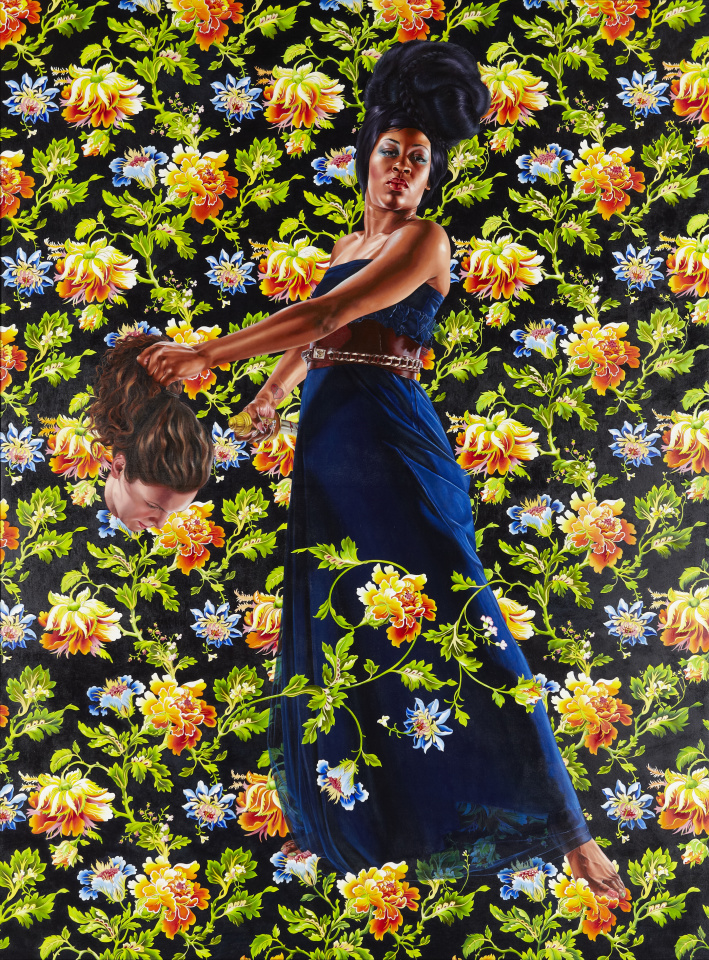Judith and Holofernes (work of art)
Artwork Info
Key Ideas
- Judith and Holofernes reimagines a biblical story in which a woman saves her town by killing the general of an invading army. Judith is portrayed as a powerful Black woman in this version of the story.
- This painting is Kehinde Wiley’s modern take on a 17th-century painting by Giovanni Baglione. The beheading of Holofernes by Judith has been depicted in paintings and sculptures throughout history.
- Many of Wiley’s portraits are based on people he meets on the street in New York City neighborhoods. The model for Judith in this painting is a woman Wiley met in a shopping mall in downtown Brooklyn. The model for the head of Holofernes is one of Wiley’s assistants.
- Wiley is known for his realistic portraiture and his “urban-meets-classical” style. His work explores the ways in which race and power are represented in art.
Learn More
Judith and Holofernes is from Kehinde Wiley’s first series of paintings to feature female subjects. The series is titled An Economy of Grace. Wiley used his “street casting” process to find the models for this series. He meets individuals (often strangers) on the streets of New York City neighborhoods and invites them to pose for portraits in his studio. The models get to choose a pose from a classical painting and reenact it. Wiley found the model for Judith at Fulton Mall in downtown Brooklyn. She is depicted wearing a dress designed by Italian fashion designer Riccardo Tisci of Givenchy, who collaborated with Wiley on his painting series. The model for the head of Holofernes is one of the artist’s assistants.
Wiley’s painting was inspired by Giovanni Baglione’s 17th-century painting titled Judith with the Head of Holofernes. The beheading of Holofernes by Judith has been depicted by different artists throughout history, especially during the Renaissance and Baroque period. In the biblical story of Judith, a Jewish town is attacked by the Assyrian army led by the general Holofernes. Judith, a widow from the town, goes to Holofernes and pretends to want to help him defeat the Jewish people. After Holofernes falls asleep, Judith cuts his head off with his own sword and the town defeats the army.
In Wiley’s modern interpretation of this story, Judith is surrounded by a bold floral pattern that swirls behind and over her body. She is depicted as a powerful Black woman wearing a designer gown and looking directly at the viewer while holding the severed head of a White woman. This painting, like Wiley’s other work, calls attention to the lack of representation of people of color in the art world. His work explores racial and gender identity and inequity, society’s ideals of beauty, and the “language of power” in art.
“What I’m doing is playing with the language of power that has existed in Western easel painting for hundreds of years, and I’m trying to use certain aspects of that to my own purposes.”
-Kehinde Wiley
Wiley has painted portraits of many influential Black artists, including Mickalene Thomas, Nick Cave, and Yinka Shonibare. In 2018 Wiley was selected to paint Barack Obama’s presidential portrait.
tags: allusion, heroine, storytelling, women, identity, power, conflict
Additional Resources
Resources for Teachers:
- Read an article about Judith’s iconic role in art history.
- Read an interview with Kehinde Wiley.
- Review a classroom resource from the National Portrait Gallery, to help facilitate a discussion about Kehinde Wiley.
Resources for Students:
- Watch a video about Kehinde Wiley’s portraiture.
- Watch a video of the artist explaining his “street casting” process.
- Create a portrait of a friend.

